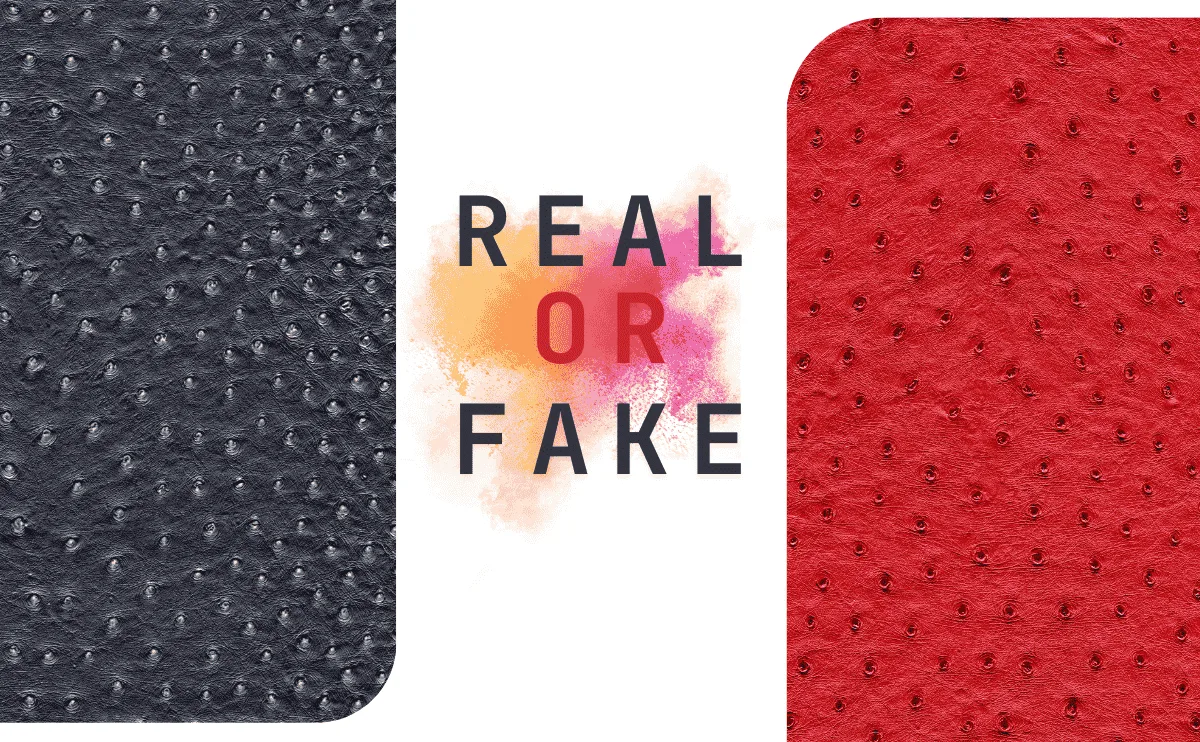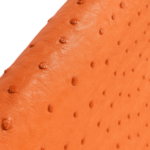How Can You Tell If Ostrich Leather Is Real?

If you've ever bought leather, you've probably heard of ostrich leather. But how do you know if you're buying real ostrich leather? And how do you tell the difference between real and fake ostrich leather?
Identifying real ostrich leather is a must for every buyer. In this article, we share with you ways to identify it and examine the most common ways buyers need to know when buying real ostrich leather.
What Does Real Ostrich Leather Look Like?
The most iconic feature of genuine ostrich leather is its wattle pattern – evenly spaced, prominent ridges that appear on the leather’s surface. These ridges are the follicles to which the bird’s feathers were attached.
No two pieces of real ostrich skin are exactly alike. The pattern varies slightly depending on the age of the ostrich and how the skin was cut and tanned. If you see a perfectly repeated pattern or one that is too symmetrical, be suspicious - it may not be genuine ostrich leather.
Does Genuine Ostrich Leather Feel Different?
Yes, absolutely. One of the easiest ways to tell if leather is real is to feel it. Natural ostrich leather is soft, supple, and slightly oily because of its natural oils. It should never feel stiff, too smooth, or plasticky.
Another test is flexibility. Gently bend the leather. Real ostrich leather bends easily without cracking. Counterfeit versions are often stiff and lack the softness and suppleness of ostrich leather.
Are There Specific Areas of the Skin That Matter?
Yes. The most valuable part of ostrich skin is called the crown, which is located on the back of the bird. This is where the claw pattern is most visible, and most genuine ostrich leather products are made from this part.
If you buy a bag or belt labeled as ostrich leather but don’t see any bumps or changes in texture, it may be made from a part of the skin or, worse yet, a synthetic one.
How Can You Test Real Ostrich Skin at Home?
To test the authenticity of leather, I suggest a few simple steps that you can easily do at home:
1. Water penetration test
Pour a small amount of water onto a piece of ostrich leather. Genuine ostrich leather absorbs it slowly, but counterfeit materials repel or absorb water quickly.
2. Smell test
Genuine leather has a rich, earthy smell, but counterfeit leather often smells like chemicals or plastic.
3. Stretch and Grain Test
Gently pull the leather and observe the grain. Real ostrich skin will show tiny natural pores and grains. Fake materials usually stretch uniformly or peel under pressure.
Is Real Ostrich Leather Always Expensive?
Yes—and that’s a helpful clue. If you find a product claiming to be made from genuine ostrich leather at a suspiciously low price, you should question it. Quality real ostrich leather is rare, and its processing is complex. This contributes to the higher price.
Always compare prices with trusted sources or industry suppliers like LeatherBulk, who specialize in sourcing authentic exotic leathers globally.
What Are Common Fakes and Alternatives?
Some manufacturers try to mimic the look of ostrich skin using embossed cowhide or synthetic PU leather. These fake options are often called:
"Ostrich print leather"
"Ostrich-style leather"
"Imitation ostrich skin"
While they may look similar from afar, they lack the quality, smell, durability, and prestige of real ostrich leather.
Can Certifications Help Identify Real Ostrich Skin?
Yes, they can. Trusted suppliers often provide certificates of authenticity or documents showing the leather's origin. If you are buying in bulk, always ask for proof that the ostrich skin is genuine.
Some tanneries use stamps or raised marks on larger skins to indicate authenticity. This helps to show the authenticity of the product.
Why Is It Important to Buy from Reputable Suppliers?
Since you spend much money buying ostrich leather, the product you receive must be authentic and use environmentally friendly and first-class materials in the production process. Therefore, choosing the proper manufacturer or supplier is one of the most important factors.
LeatherBulk has defined all of these as part of its policies to provide first-class material to its customers. To receive advice or buy genuine ostrich leather, contact us.
Final Thoughts
To summarize, here’s your quick checklist to identify genuine ostrich leather:
- Quill pattern with natural variation
- Soft, slightly oily feel
- Earthy leather scent
- Absorbs water slowly
- Price matches the quality
- Comes from a trusted source
- Documentation or certification is available
If you still have doubts, consult an expert—or better yet, buy from suppliers known for their expertise in real ostrich skin products.
Al Quoz Industrial Area, United Arab Emirates




